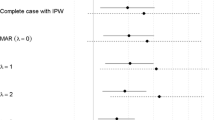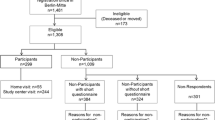Abstract
Dropouts in cohort studies can introduce selection bias. In this paper, we aimed (i) to assess predictors of retention in a cohort study (the SUN Project) where participants are followed-up through biennial mailed questionnaires, and (ii) to evaluate whether differential follow-up introduced selection bias in rate ratio (RR) estimates. The SUN Study recruited 9907 participants from December 1999 to January 2002. Among them, 8647 (87%) participants answered the 2-year follow-up questionnaire. The presence of missing information in key variables at baseline, being younger, smoker, a marital status different of married, being obese/overweight and a history of motor vehicle injury were associated with being lost to follow-up, while a self-reported history of cardiovascular disease predicted a higher retention proportion. To assess whether differential follow-up affected RR estimates, we studied the association between body mass index and the risk of hypertension, using inverse probability weighting (IPW) to adjust for␣confounding and selection bias. Obese individuals had a higher crude rate of hypertension compared with␣normoweight participants (RR = 6.4, 95% confidence interval (CI): 3.9–10.5). Adjustment for confounding using IPW attenuated the risk of hypertension associated to obesity (RR = 2.4, 95% CI: 1.1–5.3). Additional adjustment for selection bias did not modify the estimations. In conclusion, we show that the follow-up through mailed questionnaires of a geographically disperse cohort in Spain is possible. Furthermore, we show that despite existing differences between retained or lost to follow-up participants this may not necessarily have an important impact on the RR estimates of hypertension associated to obesity.
Similar content being viewed by others
Abbreviations
- BMI:
-
body mass index
- CI:
-
confidence interval
- HTN:
-
hypertension
- IPW:
-
inverse probability weighting
- MET:
-
metabolic equivalent
- RR:
-
rate ratio
- SUN:
-
Seguimiento Universidad de Navarra
References
Delgado-Rodríguez M, Llorca J 2004; Bias J Epidemiol Community Health 58: 635–641
Greenland S 1977; Response and follow-up bias in cohort studies Am J Epidemiol 106: 184–187
Chatfield MD, Brayne CE, Matthews FE 2005; A systematic literature review of attrition between waves in longitudinal studies in the elderly shows a consistent pattern of dropout between differing studies J Clin Epidemiol 58: 13–19
Hernán MA, Hernández-Díaz S, Robins JM 2004; A structural approach to selection bias Epidemiology 15: 615–625
Greenland S 1998; Basic methods for sensitivity analysis and external adjustment In: Rothman KJ, Greenland S, (eds.) Modern Epidemiology Lippincott Williams and Wilkins Philadelphia 343–357
Hernán MA, Robins JM. Estimating causal effects from epidemiologic data. J Epidemiol Community Health 2006; (in press).
Colditz GA, Manson JE, Hankinson SE 1997; The Nurses’ Health Study: 20-year contributing to the understanding of health among women J Womens Health 6: 49–62
Koh-Banerjee P, Wang Y, Hu FB, Spiegelman D, Willett WC, Rimm EB 2004; Changes in body weight and body fat distribution as risk factors for clinical diabetes in US men Am J Epidemiol 159: 1150–1159
Russell C, Palmer JR, Adams-Campbell LL, Rosenberg L 2001; Follow-up of a large cohort of black women Am J Epidemiol 154: 845–853
Hunt JR, White E 1998; Retaining and tracking cohort study members Epidemiol Rev 20: 57–70
Martínez-González MA, Sánchez-Villegas A, de Irala-Estévez J, Martí A, Martínez JA 2002; Mediterranean diet and stroke: Objectives and design of the SUN Project Nutr Neurosci 5: 65–73
Martín-Moreno JM, Boyle P, Gorgojo L et al. 1993; Development and validation of a food frequency questionnaire in Spain Int J Epidemiol 22: 512–519
Ainsworth BE, Haskell WL, Whitt MC et al. 2000; Compendium of physical activities: An update of activity codes and MET intensities Med Sci Sports Exerc 32: S498–S504
Bes-Rastrollo M, Pérez Valdivieso JR, Sánchez-Villegas A, Alonso A, Martínez-González MA. Validación del peso e índice de masa corporal auto-declarados de los participantes de una cohorte de graduados universitarios. Rev Esp Obes 2005; 3: 352–358.
Alonso A, Beunza JJ, Delgado-Rodríguez M, Martínez-González MA 2005; Validation of self reported diagnosis of hypertension in a cohort of university graduates in Spain BMC Public Health 5: 94
Robins JM, Hernán MA, Brumback B 2000; Marginal structural models and causal inference in epidemiology Epidemiology 11: 550–560
World Health Organization. 2000. Obesity: Preventing and Managing the Global Epidemic World Health Organization Geneva
Hernán MA 2004; A definition of causal effect for epidemiologic research J Epidemiol Community Health 58: 265–271
Cole SR, Hernán MA, Robins JM et al. 2003; Effect of highly active antiretroviral therapy on time to acquired immunodeficiency syndrome or death using marginal structural models Am J Epidemiol 158: 687–694
García M, Fernández E, Schiaffino A, Borrell C, Martí M, Borrás JM 2004; Attrition in a population-based cohort eight years after baseline interview: The Cornella Health Interview Survey Follow-up (CHIS.FU) Study Ann Epidemiol 15: 98–104
Zunzunegui MV, Beland F, Gutierrez Cuadra P 2001; Loss to follow-up in a longitudinal study on aging in Spain J Clin Epidemiol 54: 501–510
Matthews FE, Chatfield MD, Freeman C, McCracken C, Brayne CE, MRC CFAS. Attrition and bias in the MRC cognitive function and ageing study: An epidemiological investigation. BMC Public Health 2004; 4: 12–21
Pirzada A, Yan LL, Garside DB, Schiffer L, Dyer AR, Daviglus ML 2004; Response rates to a questionnaire 26 years after baseline examination with minimal interim participant contact and baseline differences between respondents and nonrespondents Am J Epidemiol 159: 94–101
Twisk J, de Vente W 2002; Attrition in longitudinal studies. How to deal with missing data J Clin Epidemiol 55: 329–337
Whelton PK, He J, Appel LJ et al. 2002; Primary prevention of hypertension: Clinical and public health advisory from the National High Blood Pressure Education Program JAMA 288: 1882–1888
Hernán MA, Hernández-Díaz S, Werler MM, Mitchell AA 2002; Causal knowledge as a prerequisite for confounding evaluation: An application to birth defects epidemiology Am J Epidemiol 155: 176–184
Acknowledgements
The authors are indebted to Dr Miguel Hernán for comments on this manuscript and Ms Carmen de la Fuente for technical assistance. Also, they thank the continuous collaboration of the participants in the SUN Study. The SUN Study has received funding from the Spanish Ministry of Health (Grants PI040233, G03/140, and PI030678), the Navarra Regional Government (43/2002 and 41/2005) and the University of Navarra. Dr Alonso was supported partially by a Fulbright fellowship and a MMA Foundation grant.
Author information
Authors and Affiliations
Corresponding author
Rights and permissions
About this article
Cite this article
Alonso, A., Seguí-Gómez, M., de Irala, J. et al. Predictors of follow-up and assessment of selection bias from dropouts using inverse probability weighting in a cohort of university graduates. Eur J Epidemiol 21, 351–358 (2006). https://doi.org/10.1007/s10654-006-9008-y
Accepted:
Published:
Issue Date:
DOI: https://doi.org/10.1007/s10654-006-9008-y




